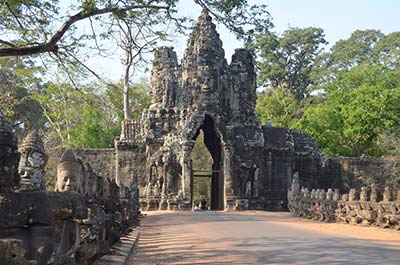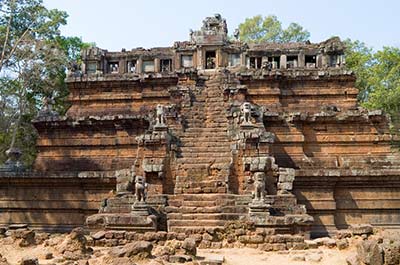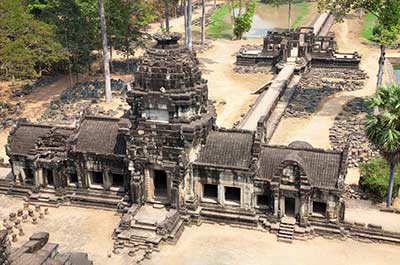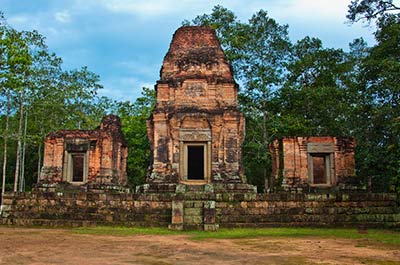
Ta Prohm
Temple known for the massive trees growing out of its walls
One of the most famous temples in Angkor, the Ta Prohm is known for the huge trees and the massive roots growing out of its walls.
“The tomb raider” movie
The jungle temple also featured in the adventure movie “The tomb raider”; several shots were filmed in the Ta Prohm.
Left in overgrown state
The temple was intentionally left in much the same way as it was when Henri Marchal, curator and conservator of the EFEO did some basic clearing work in 1920. Only the most necessary work to prevent further deterioration and collapse was done. The attractive jungle setting and the original state of the temple has made it one of the most visited Angkor temples.
Lately, things have changed at the Ta Prohm. The protect the temple from growing roots damaging the structure and from the danger of falling trees destroying the monument, a number of trees have been removed and restoration works have been carried out.
Buddhist temple
The Ta Prohm was build during the last decades of the 12th century by King Jayavarman VII. Where the older Angkor temples were Hindu temples dedicated to Shiva and Vishnu, the Ta Prohm is a Buddhist temple, as King Jayavarman VII was a follower of Mahayana Buddhism. The King dedicated the temple to his mother.
The stele of the Ta Prohm
A lot of knowledge about the Ta Prohm is gained from the stone stele dated 1186 written in ancient Sanskrit language that was found in the temple. The stele praises King Jayavarman VII, Lokeshvara (a Bodhisattva in Mahayana Buddhism), Prajnaparamita (the perfection of wisdom) and the Three Jewels of Buddhism, namely the Buddha, the Dharma (the Buddhist teachings) and the Sangha (the Buddhist community).
Detailed info on the stele
It contains a list of all products used for religious ceremonies and lists the number of villages, priests and dancers that were to serve the temple.
The stele also mentions that at the time there were 102 hospitals spread over the Khmer empire and a list of items that each hospital was to keep in stock.
The stele then cites that there were 121 rest houses spread over the empire, along the major routes from Angkor to places as far away as Phimai in Thailand or the Kingdom of Champa in present day Vietnam.

Layout of the Ta Prohm temple complex
The Ta Prohm’s fifth enclosure, which is the most outer one, is more than one kilometer long and 600 meters wide. The large gopuras (entrance gates) were decorated with large faces of Lokeshvara in all four directions, similar to those of the Bayon. Lokeshvara is a Bodhisattva representing the compassion of the Buddha. Only the Western gate is well preserved.
Rest house for pilgrims
From the main Eastern entrance, a 350 meter long path leads to a terrace with guardian lions and Naga balustrades that crosses the moat. In front of the terrace is a rest house for pilgrims visiting the temple.
According to inscriptions of the temple’s stele thousands of men and women who were attached to the Ta Prohm temple as priests, dancers or servants lived within the fifth enclosure.
The 4th enclosure with the Hall of Dancers
The East gate of the fourth enclosure contains depictions of several Buddhist scenes. The faces of most images of the Buddha were destroyed halfway through the 13th century when king Jayavarman VIII reinstated Shaivism as the official religion. Only a few have survived, maybe because they were mistaken for a Hindu figure.
The fourth enclosure that measures just 110 meters by 100 meters contains a moat surrounding the temple. Inside the walls of the enclosure are 93 small cells for the Buddhist monks of the temple.
On the East end of the temple, which is the main entrance, is a structure called the “Hall of Dancers”. It got its name from the many dancing Apsara figures that decorate the structure.

Buddhist scenes of the 3rd enclosure
At the East end of the third enclosure are cruciform galleries that delimit four small courtyards. Around it is a number of small sanctuaries. Carved panels show depictions of several Buddhist scenes.
A scene from the Jataka tales
One of them displays a scene from one of the Jataka tales. It depicts Prince Vessantara pouring water in the hands of the Brahmin Jujuka after he gave away his two children to work as servants. Vessantara gave away everything he owned in order to practice the virtue of charity.
Satellite temples
At the center of the North and South enclosure wall are satellite temples, that were probably build later.
The South temple contains several Buddhist scenes, including Buddha’s great departure. It tells of the Gautama Buddha, who was born a Prince named Siddhartha and lived in a Palace until he was 29 years old. Siddhartha decided to leave the Palace to live a life of abstinence and meditation in order to finally reach enlightenment.
The central sanctuary
The central sanctuary is enclosed by galleries with a tower at each of its corners. The square central courtyard is 24 meters long, a single sanctuary tower is set in its center. The South East corner of the courtyard contains a library building.
Location
The temple is located about thirteen kilometers Northeast of the center of Siem Reap, just East of Angkor Thom.
How to get there
A fun way to get there is by tuk tuk.
Find out about prices, how to find a good tuk tuk driver and what to do before the trip.
Alternatively, get there by taxi, motorbike or rented bicycle.
Other Angkor temples:











